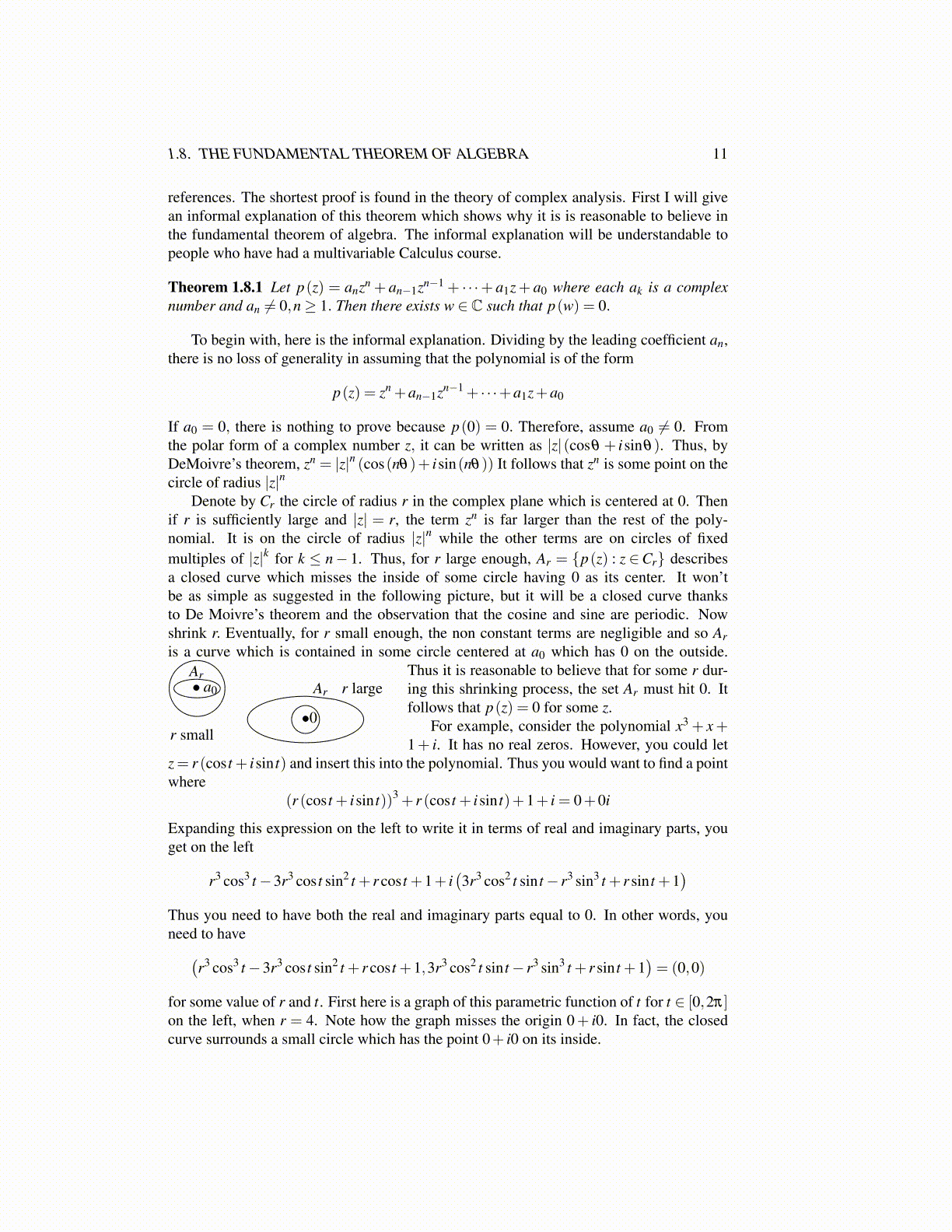
1.8. THE FUNDAMENTAL THEOREM OF ALGEBRA 11
references. The shortest proof is found in the theory of complex analysis. First I will givean informal explanation of this theorem which shows why it is is reasonable to believe inthe fundamental theorem of algebra. The informal explanation will be understandable topeople who have had a multivariable Calculus course.
Theorem 1.8.1 Let p(z) = anzn + an−1zn−1 + · · ·+ a1z+ a0 where each ak is a complexnumber and an ̸= 0,n≥ 1. Then there exists w ∈ C such that p(w) = 0.
To begin with, here is the informal explanation. Dividing by the leading coefficient an,there is no loss of generality in assuming that the polynomial is of the form
p(z) = zn +an−1zn−1 + · · ·+a1z+a0
If a0 = 0, there is nothing to prove because p(0) = 0. Therefore, assume a0 ̸= 0. Fromthe polar form of a complex number z, it can be written as |z|(cosθ + isinθ). Thus, byDeMoivre’s theorem, zn = |z|n (cos(nθ)+ isin(nθ)) It follows that zn is some point on thecircle of radius |z|n
Denote by Cr the circle of radius r in the complex plane which is centered at 0. Thenif r is sufficiently large and |z| = r, the term zn is far larger than the rest of the poly-nomial. It is on the circle of radius |z|n while the other terms are on circles of fixedmultiples of |z|k for k ≤ n− 1. Thus, for r large enough, Ar = {p(z) : z ∈Cr} describesa closed curve which misses the inside of some circle having 0 as its center. It won’tbe as simple as suggested in the following picture, but it will be a closed curve thanksto De Moivre’s theorem and the observation that the cosine and sine are periodic. Nowshrink r. Eventually, for r small enough, the non constant terms are negligible and so Aris a curve which is contained in some circle centered at a0 which has 0 on the outside.
•0
Ar r large• a0
Ar
r small
Thus it is reasonable to believe that for some r dur-ing this shrinking process, the set Ar must hit 0. Itfollows that p(z) = 0 for some z.
For example, consider the polynomial x3 + x+1+ i. It has no real zeros. However, you could let
z= r (cos t + isin t) and insert this into the polynomial. Thus you would want to find a pointwhere
(r (cos t + isin t))3 + r (cos t + isin t)+1+ i = 0+0i
Expanding this expression on the left to write it in terms of real and imaginary parts, youget on the left
r3 cos3 t−3r3 cos t sin2 t + r cos t +1+ i(3r3 cos2 t sin t− r3 sin3 t + r sin t +1
)Thus you need to have both the real and imaginary parts equal to 0. In other words, youneed to have(
r3 cos3 t−3r3 cos t sin2 t + r cos t +1,3r3 cos2 t sin t− r3 sin3 t + r sin t +1)= (0,0)
for some value of r and t. First here is a graph of this parametric function of t for t ∈ [0,2π]on the left, when r = 4. Note how the graph misses the origin 0+ i0. In fact, the closedcurve surrounds a small circle which has the point 0+ i0 on its inside.